Some animals are just built differently than others. The ecological role they fill places them at the top of the food chain. Once they’ve grown into adults, they have little to fear from other predators. These animals are what we classify as apex predators.
What is an Apex Predator?

An apex predator is defined as an organism that sits at the top of the food chain in an ecosystem. They prey on multiple other species in their ecosystem, while (normally) having no other organisms that prey on them.
There are some exceptions in the animal kingdom when apex predators become prey, and some of them will be noted in this article. For the most part, the only threat to an apex predator is a larger individual of the same species or larger, hostile herbivores.
An apex predator does not have to be the largest animal in its environment, but in many cases, they are larger animals. Most predation of apex predator species occurs when individuals are still juveniles and therefore vulnerable.

12 of the World’s Top Apex Predators
1. Orcas

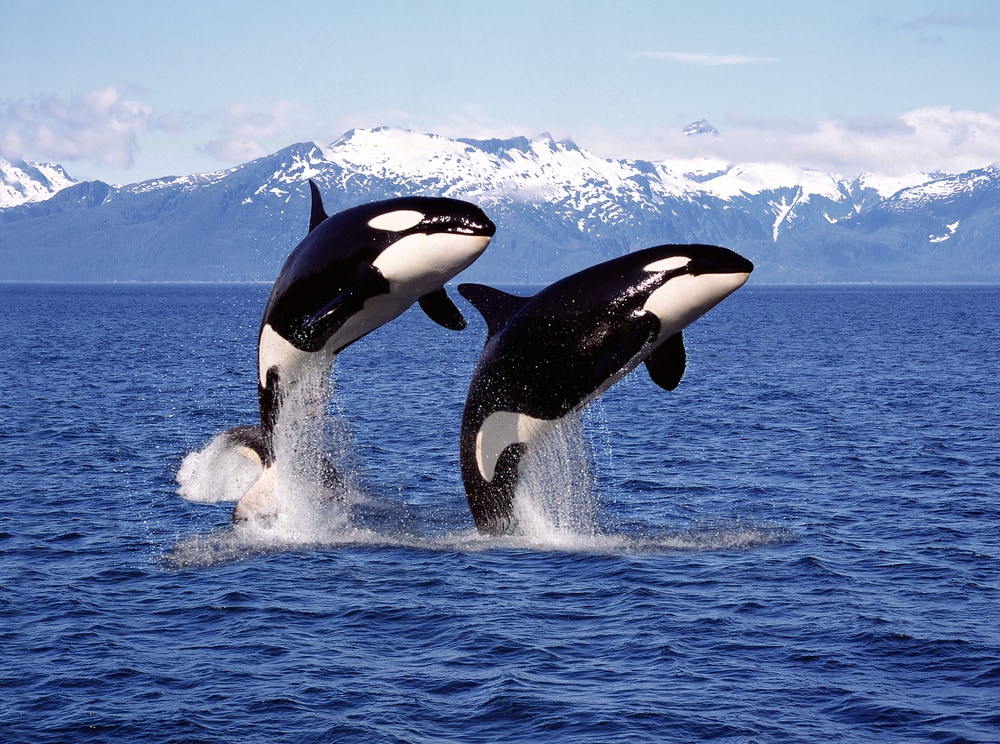

Killer whales are the largest species in the dolphin family. They can be found nearly worldwide, with higher populations in the southern oceans near Antarctica, but also in the Arctic, off the coasts of Alaska and New England, and in African waters. In the wild, these animals can live anywhere from 30 to 90 years, reach lengths of over 30 feet (10 meters), and weigh as much as 11 tons (9,979 kilograms).
Orcas live, hunt, and play in familial groups called pods. These groups can number from just a few to over twenty individuals, and pods have been seen to group together for mating or hunting large prey.
Orcas are one of the most intelligent species on the planet. Scientists believe orcas communicate with each other to the extent of nearly having their own language. They use their intelligence to form both highly complicated hunting strategies and complex social structures.
An orca’s diet varies depending on where they live regionally, as well as learned behaviors of the pod. Some groups may almost entirely eat fish, while others feed mostly on marine mammals like seals.
After more study and observation, killer whales have essentially become the undisputed apex predator of the oceans. Recently, a pod of whales was videoed hunting and preying on the world’s largest animal, a blue whale. Aside from human hunting activity and pollution, there are basically no threats to orcas from predation.
The former top predator of the oceans was the great white shark, however, it’s been documented that orcas specifically prey on them and will eat their livers. This does bring us to our next apex predator though.
2. Sharks



In nearly any marine environment in the world, you’ve going to find species of sharks. Millions of years of evolution have left them largely unchanged, mostly because of how well-adapted and successful biological sharks have become.
At the pinnacle of the shark food chain is the great white. Growing to over twenty feet in length and weighing in at up to 4,500 pounds (2,000 kg), white sharks are the largest of the predatory sharks. Only basking sharks, megamouth sharks, and whale sharks grow larger, but they both feed almost exclusively on plankton.
The only threats white sharks face are from humans, larger white sharks, and orcas. They mostly feed on marine mammals like seals, stalking them from what is called kill zones. The sharks hug the deeper water, waiting for seals to venture out for food. When they do, the white sharks strike from below and behind.
Aside from white sharks though, sharks dominate marine ecosystems. Tiger sharks, bull sharks, and hammerheads all sit at the top of their respective food webs with only larger sharks as a threat.
3. Tigers

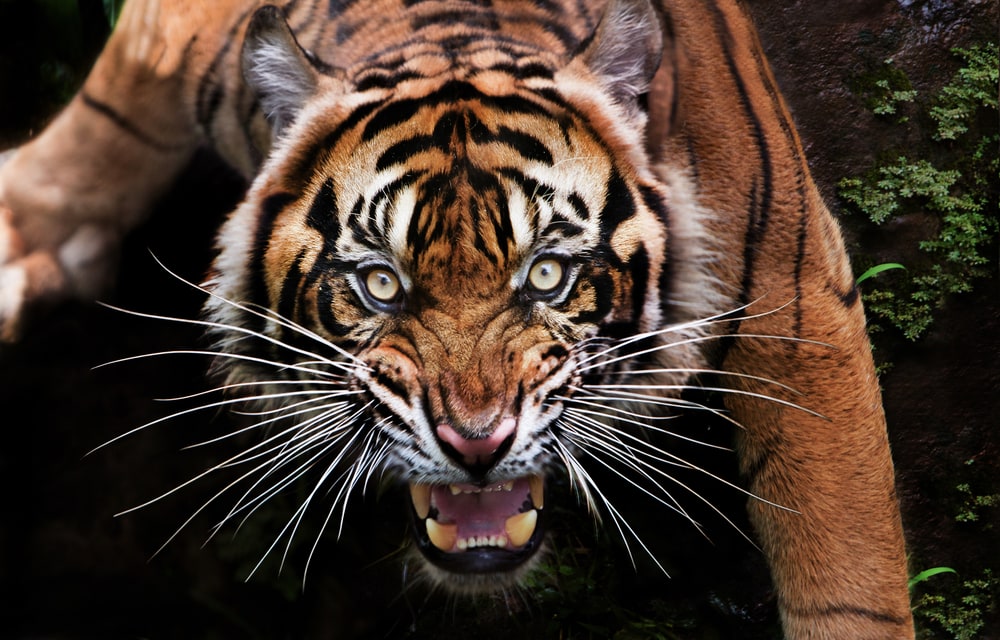
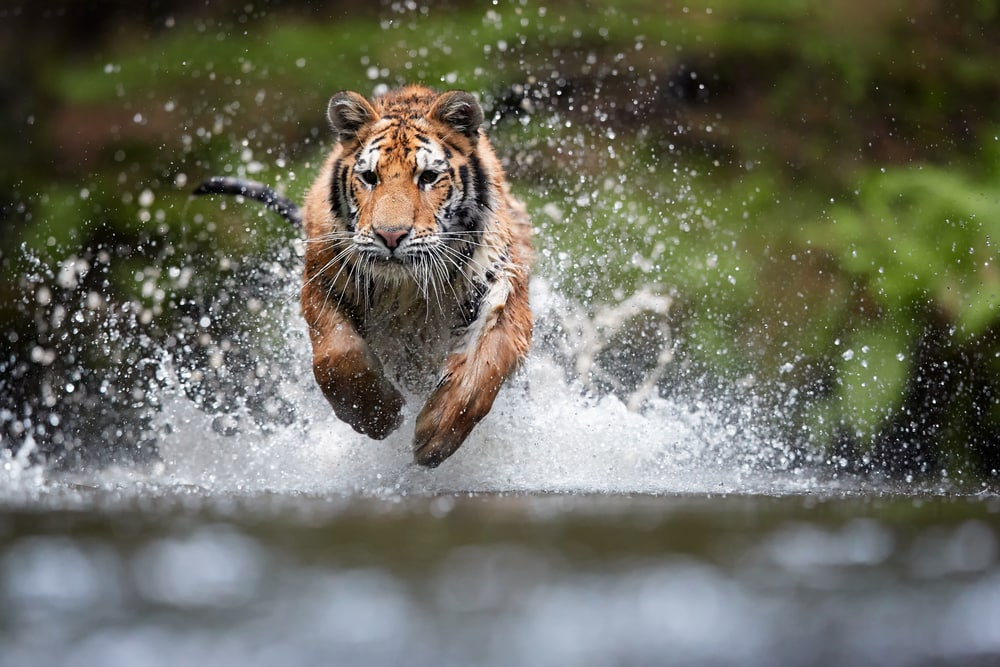
Tigers are one of the largest big cats in the world, with some specimens weighing well over 600 pounds (270 kg). You can find them roaming throughout Asia, from India and China to the polar forests of Siberia.
Unlike a lot of other big cats, tigers love the water. They’re great swimmers and frequent watering holes and rivers.
Most tigers live solitary lives and defend the vast expanses of land they claim as their territory from other tigers. While they have no natural predators, tigers prey on just about everything.
They’ve been found to feed on everything from rabbits and salmon to deer and wild boar, and even small bears.
Humans are the real threat to tigers. Over time, we’ve hunted them to near extinction for their fur, out of fear, and for their use in traditional Chinese medicine. China funds tiger farms, where tigers are bred and raised in order to be used in medical practice or for their hides. Population fragmentation, urban expansion, and habitat degradation are also threats to wild tiger populations.
4. Wolves


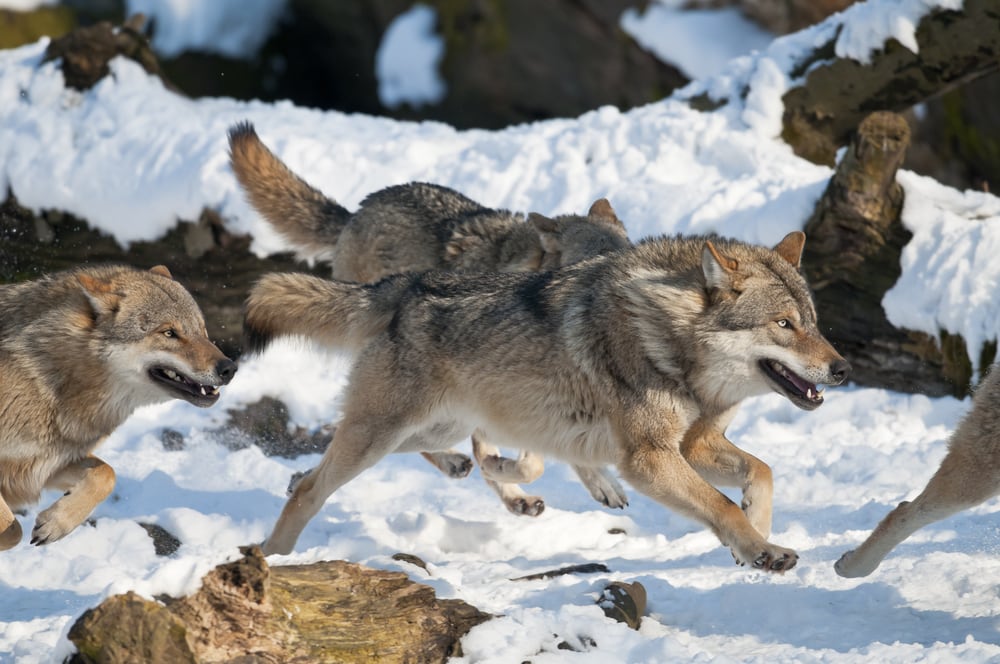
All types of wolves can be found throughout North America and Eurasia, mostly in temperate climates. What makes wolves apex predators is the lack of natural predators and the fact that they live in packs which allow them to take down prey much larger than themselves.
A typical wolf weighs under 100 pounds (45 kilograms). Despite their size, they live in complex social groups called packs. These are usually around eight members, however, it isn’t uncommon for large packs of well over twenty individuals to form.
Wolves aren’t picky eaters and will go after anything from rabbits to lizards. The bulk of their diet consists of hoofed terrestrial mammals like elk, bison, moose, goats, and deer. With enough members, a pack can take down the larger species of that group, but wolves are intelligent and specialize in taking down weak and vulnerable members of herds.
In environments where they meet, tigers, brown bears, and cougars all pose significant threats to wolves. In a one-on-one matchup, the wolves lose the fight. As a pack, they are able to compete over kills, but will generally simply back away when larger animals come near. Aside from Siberian tigers who will suppress wolf populations to near extinction, they have no natural predators.
5. Bears



The large, fuzzy mammals we call bears tend to dominate every environment they can be found in. Most bear species are omnivorous, feeding on everything from berries and fish to large mammals. Around the world, there are eight types of bears.
Polar bears are the undisputed king of the Arctic. They’re perfectly adapted creatures that specialize in hunting seals from platforms on pack ice. Nothing in their environment is a threat to them. As the largest bear species in the world, even if their territory overlaps with other bear species, they claim superiority. For more information on polar bears, check out our article on the Polar Bears in Alaska.
Brown bears reign over the regions south of the Arctic Circle that polar bears claim dominion over. Grizzly bears are actually a subspecies of brown bears found in inland environments. These bears can single-handedly take down moose when the opportunity presents itself but will eat a variety of foods from berries to salmon as well.
Black bears are found in larger numbers east of the Mississippi River in North America. They’re much smaller than their 600-plus pound (270 kg) cousins, usually weighing in between 60 to 300 kilograms (130 to 660 pounds), with most specimens on the lower end.
Bears regularly chase other predators away from carcasses to feed. Their size and power make them formidable foes for the other animals in their environments, and it’s usually better to flee than fight them.
The lovable and placid pandas are the only bears that aren’t considered apex predators. They live on a diet of bamboo, not meat.
6. Lions



The African lion is a symbol of strength for good reason. These sub-Saharan big cats can weigh in at up to 500 pounds (200 kg). On the African savannah, lions find little challenge as they hunt for prey among the herds of zebra, wildebeest, and antelope species.
Lions once were found throughout the African continent, but have been deemed extinct outside of sub-Saharan Africa due to a variety of reasons including a changing climate, lack of prey species, and human activity.
Typically, lions live in groups of up to fifteen, containing one to four males. They can also form smaller groups of males, small lioness groups, or prides of up to thirty lions. Their size and numbers allow them to attempt to take down large prey like water buffalo, and easily bring down animals like zebras, antelope, and wildebeest. They have one of the widest prey spectrums in Africa.
The main conflict for lions only comes from hyenas or territorial disputes with other lion prides. Hyenas and lions both target the same species for food, and will sometimes even fight for no apparent reason. Interactions are dependent on the region and learned behaviors, where hyenas will back off in some regions and chase lions off in others.
Despite this, hyenas are not major threats to adult lions and do not prey on them. Their competition for food and territory is usually won by lions, with hyenas depending on numbers to compete.
7. Jaguars



The undisputed and unchallenged apex predator of south and Central America is the Jaguar. With one of the strongest bite forces on the planet and a vast diet, jaguars are the kings of the rainforest.
A typical jaguar weighs up to 250 pounds (110 kg) and has jaws capable of crushing bone and shells. In fact, their hunting methods depend on stealth and their bite. Jaguars tend to launch sneak attacks, grabbing their prey by the skull or along the spine and puncturing through with their teeth. This is a very different hunting method from African big cats that tend to suffocate prey.
Jaguars will eat almost anything in their environment. Their favorite foods include reptiles like turtles, caiman, and snakes, but they’ll also target mammals like capybara and tapir, fish, monkeys, and birds.
In their native environment, nothing is a real threat to a jaguar. This is incredibly evident when they come into contact with people, as they aren’t afraid since they’re the ones that other animals back down from. While some have learned fear of humans, jaguars are used to being the top dog (or cat).
8. Cougars


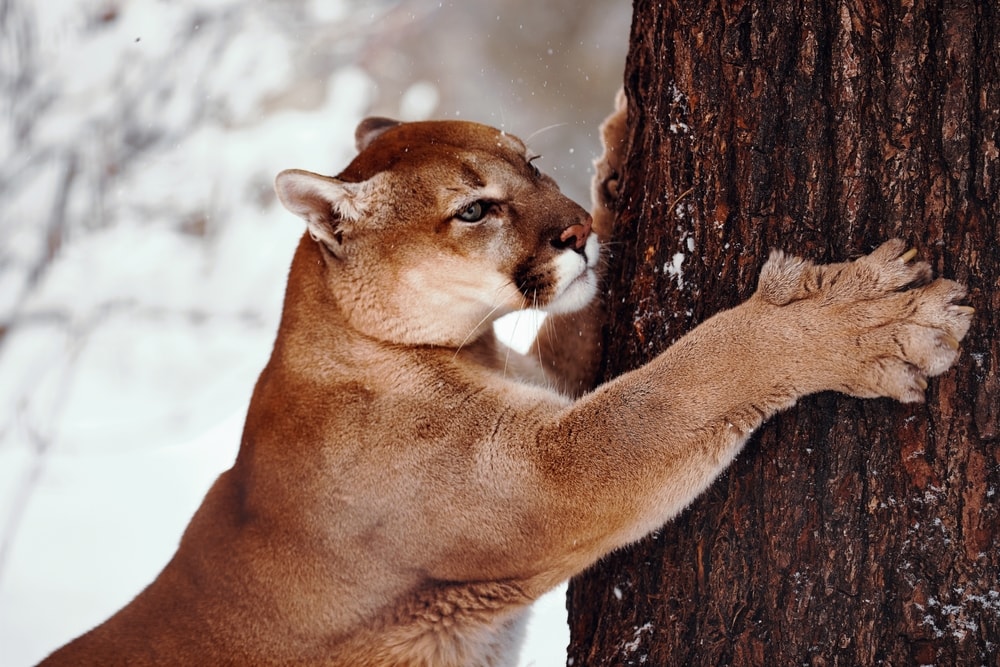
Cougars, pumas, or mountain lions, it doesn’t matter what you call them. These big cats of North America are niche apex predators. While they will yield kills to larger predators like black bears, jaguars, wolves, or even a coyote pack, cougars are a top predator.
The solitary pumas usually have large territories and a low population density. They can be found from the northern Yukon Territories to the Andes Mountains of South America. Typically, you’ll find the most cougars in mountainous areas that are heavily forested.
Pumas prey on a variety of animals, with most of their diet consisting of deer species. They’ll also eat insects, rabbits, and rodents.
Cougars have been known to stalk and attack humans, but attacks and fatal interactions have become incredibly rare. Despite conflict, no other predators target cougars aside from humans.
One interesting note, cougars have a very human-like, scream sound they’ll emit. You can listen to an example below. It’s theorized that these screams are the origin of myths like skinwalkers.
9. Leopard Seals
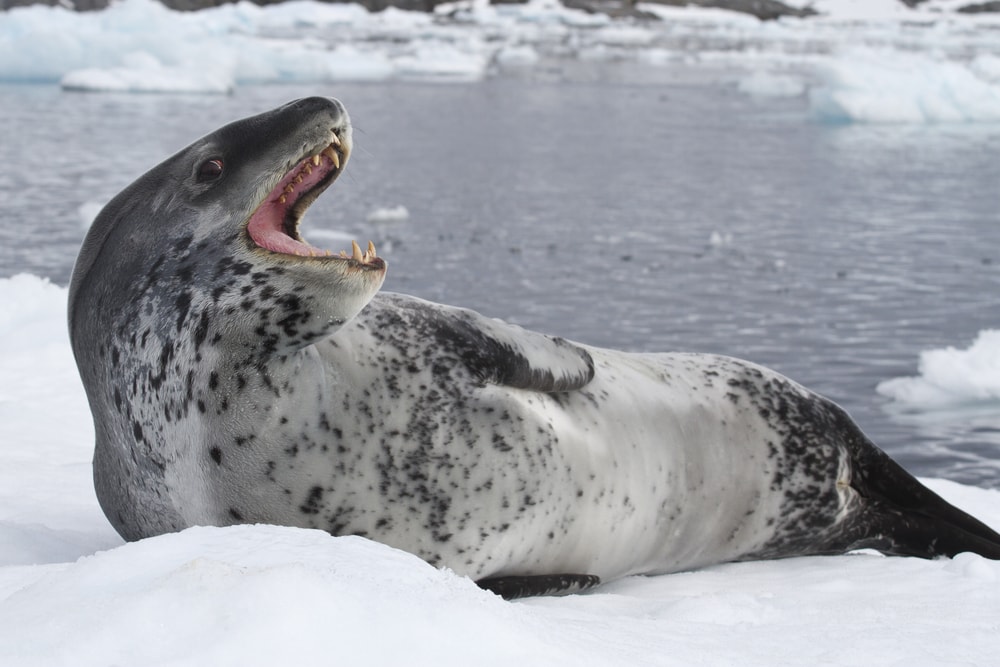


Leopard seals are the second-largest seal species in the Antarctic and the most predatory. They have huge heads compared to their body size, with strong jaws and sharp teeth that give it the edge while hunting. The only known predator of these seals is the orca.
Leopard seals are found throughout Antarctic waters and spend most of their lives living on and around sea ice. They tend to be solitary animals, with the only groups you’re likely to see being mothers with pups.
Leopard seals feed on a wide variety of marine life. Fish, penguins, and even other seal species fall victim to them. While juveniles, they’ll feed on krill until they reach an age where they can move on to more substantial food sources.
Leopard seals are unable to bite chunks of food off of their prey. It typically holds prey between its jaws and shakes it back and forth to tear it apart.
The largest threat to leopard seal populations is global warming. Since they depend on sea ice and the Antarctic environment, as temperatures rise and ice melts, their habitat is destroyed.
10. Komodo Dragons



The largest species of lizard still living on the planet is the Komodo Dragon. Growing to 10 feet in length (3 meters) and weighing up to 150 lb (70 kilograms), they’re essentially unchallenged in their native environments.
The Komodo Dragon is native to a few Indonesian islands, such as Komodo (hence the name), Rinca, Flores, and Gili Motang. Despite a small native range, they’ve developed quite a reputation.
They’re ambush predators that lie in wait until suitable prey comes by, then rush at them and try to bring them down through a combination of brute force and blood loss. They’re also known to be scavengers, eating carrion and corpses that they come across.
It was once thought they had toxic saliva that helped bring down prey, allowing them to track an animal after an attack to eat it after succumbing to the poison. This was later disproved by research in 2013.
Komodo dragons are incredibly strong and fast animals. They eat by swallowing their prey whole or in chunks, sometimes ramming into objects to help jam food down their throats. This process has been documented to even knock down trees.
Large mammals top the list of favorite prey for adults, but dead bodies (including humans), eggs, smaller Komodo dragons, reptiles, birds, monkeys, goats, and wild boar.
11. Crocodilians



Most members of the crocodilian family are apex predators in their ecosystems. Like sharks, these aquatic reptiles have largely remained unchanged for millions of years.
Saltwater crocodiles are some of the most dangerous and powerful animals on the planet. Native to Southeast Asia and Australia, these crocodiles are able to survive in fresh, brackish, and marine waters. Most of the time, they’re ambush predators and will feed on anything they can grab from sharks and other crocodiles to fish and terrestrial mammals that wander too close to the water.
Nile crocodiles can be found throughout the freshwater environments of Africa. As generalist predators, they feed on a vast number of other species. They’ll take down prey like gazelles, zebras, and antelope when they come to the water to drink. Nile crocodiles are also fairly social, sharing basking space, food sources, and territory. Their most dangerous opponents are hippos.
The American alligator is capable of reaching lengths of fifteen feet and weighing over a thousand pounds. They primarily inhabit the swamps and lakes of the Southeastern United States where they have no natural predators as adults. Despite this, juvenile alligators, eggs, and sometimes even adults fall prey to raccoons, lizards, and invasive species such as Burmese pythons.
12. Giant Otter



Perhaps a surprise on the list is an otter species. The giant river otters of South America are the longest weasel species in the world, reaching a length of over 5.5 feet (1.7 meters). They’re most commonly found in the Amazon River and in the Pantanal.
Giant otters live in groups that help them hunt and defend themselves from other top predators. They don’t have direct predators other than humans but compete with large caiman and jaguars for food.
Most of these otter’s diets consist of fish, but they’ll also eat crabs, turtles, snakes, and caiman when possible. In their hunting area, otters build what looks like campsites, where they clear large areas of brush to make a home.
Giant otters are an endangered species mostly because humans have hunted them for centuries. Their pelts are velvety-smooth and were very desirable in the early 1900s.
You May Also Like: Discover These More Than 21 Animals with Horns and Antlers with Photos, Infographics, Facts, and more!
Most Dangerous Apex Predators for Humans

What might be surprising to most people is that apex predators are rarely a threat to humans, in fact, it’s usually the other way around. There are honestly a lot of reasons why this is the case, but mainly it’s because most of them live in very remote areas and don’t come into contact with people most of the time.
There are documented cases of man-eating apex predators such as the lions of Tsavo or the Champawat Tigress. These cases are rare. For the twelve species we’ve listed, here are approximate numbers of human deaths per year, caused by each.
- Orcas (0, no documented attacks)
- Great White Sharks (2 deaths per year, only around 70 unprovoked attacks by any shark species per year.)
- Tiger (1800 deaths per year between 1800 and 2009, recent years between 50 and 250)
- Wolves (21 fatal attacks ever recorded.)
- Bears (40 attacks per year, low percentage of fatalities.)
- Lions (200 deaths per year)
- Jaguars (24 deaths per year.)
- Cougars (27 fatal attacks in last 100 years)
- Leopard Seal (1 documented fatal attack ever)
- Komodo Dragon (5 deaths since 1974)
- Crocodiles (300 deaths per year by Nile crocodiles, 2 per year in Australia by Saltwater Crocodiles.)
- Giant Otters (0, no documented attacks.)
It should be pretty obvious by the numbers that not all of these apex predators are regularly attacking humans, let alone killing them.
One thing that should be addressed is the fact that animals don’t hunt humans. In most cases, this is true. Animals are either provoked, attacked due to a misunderstanding, or out of desperation. But on rare occasions, animals do actively seek out, target, and feed on humans.
Crocodiles are one species that hunt people, and not due to habitat encroachment or provocation. When a crocodile attacks a human and realizes that they’re easy prey, they tend to hang around that settlement and continue to attack people there.
Man-eating accounts among other animals are rare. The most dangerous animals to people are usually not apex predators. Mosquitos are responsible for an estimated one-million human deaths per year, snakes are responsible for roughly 50,000 and hippos regularly kill over 500 people per year.
You may also like: Learn The Difference and Similarities Between Jaguars vs Leopards with Photos, Infographics, FAQs, and more!
FAQ
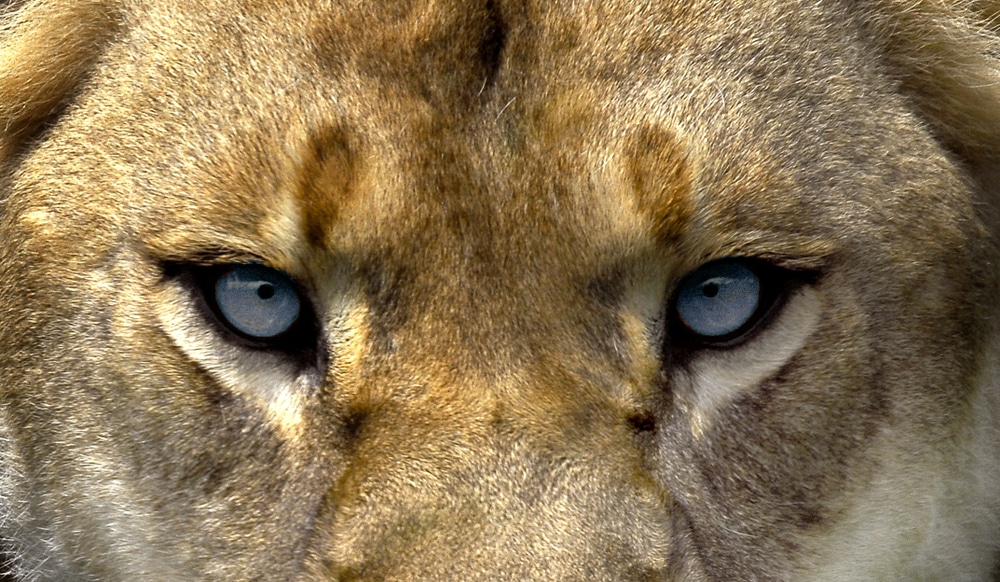
1. What Happens Without Apex Predators?
Apex predators are often also keystone species of ecosystems. Without them, the natural order collapses and must find a new equilibrium. I’ve said it before, and many people believe that nature always finds equilibrium and balances out. While this is true, that balance point can also be a biologically void and barren environment.
Apex predators tend to be the main limiter in ecosystems. They’re what keeps other species’ populations in check. Without them, those species can populate out of control, throwing everything else into disorder.
The wolves of Yellowstone are a great example. Humans hunted wolves in the Yellowstone region to complete extinction due to concerns for cattle, wildlife populations, and general fear of them.
Without wolves, elk populations were able to multiply exponentially. As their number hit a critical mass, the environment could barely sustain them. Increased competition for food led to overgrazing, where grasses can’t grow back fast enough to be eaten again. Reeds along rivers were uprooted and eaten, leading to huge erosion and loss of shoreline trees.
These things massively impacted other animals in the area. Beaver populations fell and the landscape itself changed. All because wolves were no longer present.
Reintroducing wolves to Yellowstone has been mostly considered a success. As they whittled down elk populations, the area was slowly restored to its original state, with most of the damage being mitigated.
Removing apex predators from environments causes either other animals to flourish and overpopulate or a collapse of the ecosystem itself. These problems creep in when other animals aren’t able to take up the same ecological niche that the predators inhabited.
2. Are Humans Considered Apex Predators?
The insulation of cities, dependence on agriculture, domestication of food animals, and technological advancement have all kind of just removed humans from the food chain. People aren’t preferred prey for other animals and we can eat any animal we wish. But, humans don’t fill a niche in an ecosystem and are rather removed from the entire process.
That isn’t to say that we don’t have a massive impact on ecosystems. Of all species, humans have the largest impact on ecosystems through pollution, overhunting, and habitat destruction.
The best way to explain humans in the food web would be that we removed ourselves from it, but then placed ourselves at the top and outside of it. It’s almost like the kitchen in your home is the food web and you walk in and grab snacks from the pantry but then head back to the living room.
Humans are relatively low in the actual food chain. We’re above consumers like plants and can prey on other animals, but without our tools and technology we would be easy prey for animals like lions, tigers, and bears (oh my!).
Some people may argue that people are the top predators on the planet. I would argue that we don’t really qualify. Removing ourselves from the natural world and the way nature works has benefited us as a species in almost innumerable ways, but it has also removed us from the processes.
Again, our impact is still ridiculous. We’ve brought and continue to bring species to extinction, in many cases simply because of overhunting them. We also have the ability to bring animals back into ecosystems that we removed them from, such as reintroducing wolves to Yellowstone.
I think humans can be more accurately described as mad scientists playing god rather than apex predators. We can directly control populations of species on local and regional levels, while at the same time being under no threat from those animals.
It’s a complicated situation that we must approach with wisdom and open-mindedness. As new information is found, we should refine our attitudes and activities. Careful approaches and thoughtful actions are what will be needed to steward the planet we have found ourselves in charge of.









